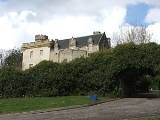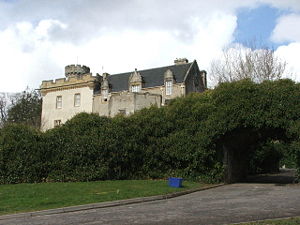
Tulloch Castle
Encyclopedia

Dingwall
Dingwall is a town and former royal burgh in the Highland council area of Scotland. It has a population of 5,026. It was formerly an east-coast harbor but now lies inland. Dingwall Castle was once the biggest castle north of Stirling. On the town's present-day outskirts lies Tulloch Castle, parts...
in the Highlands
Scottish Highlands
The Highlands is an historic region of Scotland. The area is sometimes referred to as the "Scottish Highlands". It was culturally distinguishable from the Lowlands from the later Middle Ages into the modern period, when Lowland Scots replaced Scottish Gaelic throughout most of the Lowlands...
of Scotland
Scotland
Scotland is a country that is part of the United Kingdom. Occupying the northern third of the island of Great Britain, it shares a border with England to the south and is bounded by the North Sea to the east, the Atlantic Ocean to the north and west, and the North Channel and Irish Sea to the...
. It dates from the 12th century, when it is thought to have been built by Norsemen
Norsemen
Norsemen is used to refer to the group of people as a whole who spoke what is now called the Old Norse language belonging to the North Germanic branch of Indo-European languages, especially Norwegian, Icelandic, Faroese, Swedish and Danish in their earlier forms.The meaning of Norseman was "people...
. Over the years, it has served as a family home for members of the Bayne and Davidson
Clan Davidson
Clan Davidson is a Highland Scottish clan. The clan was also part of the Chattan Confederation.-History:When the power of the Comyns began to wane in Badenoch, David Dubh of Invernahaven, Chief of Davidsons, having married the daughter of Angus, 6th of MacKintosh, sought the protection of William,...
clans, as a hospital after the evacuation of Dunkirk, and as a hostel for the local education authority. It is currently used as a hotel and conference centre.
History
Tulloch Castle is believed to have been built by Norsemen in the 12th century. Its first documented owners were the Bayne clan whose residence in the castle can be traced back to the 16th century.In the 18th century however, ownership of the castle changed hands. Kenneth Bayne, 8th Laird of Tulloch, sold the estate to his cousin, Henry Davidson, on the 13 January 1762. Tulloch Castle remained the property of the Davidson family until the 20th century. It became known as the seat of the Clan Davidson.
The castle passed out of Davidson ownership in 1917 when the last direct descendant of this family, Duncan Davidson, died and left the castle to his daughter and her son, Colonel Angus Vickers, of the Vickers
Vickers
Vickers was a famous name in British engineering that existed through many companies from 1828 until 1999.-Early history:Vickers was formed in Sheffield as a steel foundry by the miller Edward Vickers and his father-in-law George Naylor in 1828. Naylor was a partner in the foundry Naylor &...
aircraft company.
After serving as the Vickers' family home for several years, and as a hospital for casualties of Dunkirk in 1940, Tulloch Castle was purchased by the local education authority in 1957. It was used as a hostel for students from the west coast of Scotland who were studying at Dingwall Academy
Dingwall Academy
Dingwall Academy is the largest secondary school in the Highlands of Scotland, with an enrollment of 1005 pupils as of November 2006. The Academy is situated in the centre of Dingwall and brings in pupils from Conon Bridge, Maryburgh, Muir of Ord, Strathpeffer and the surrounding area.Dingwall...
until 1976.
After this, the castle fell into disrepair until it was renovated and converted into a hotel by local family, the MacAulays, in 1996. Now part of the Oxford Hotels and Inns chain, Tulloch Castle is used as a hotel and conference centre. It played host to the official Clan Davidson Gathering in October 2007.
Supernatural reports
There have been several claims that Tulloch Castle is haunted. Visitors and hotel staff have reported witnessing apparitions in the form of a young girl and a middle aged lady. These supernatural claims were explored in the Grampian TelevisionGrampian Television
Grampian Television is the ITV franchisee for the North and North East of Scotland. Its coverage area includes the Scottish Highlands , Inverness, Aberdeen, Dundee and parts of north Fife...
series Beyond Explanation in 2005, although no conclusive evidence exists to validate such reports. On 28 May, 2008 it was reported by the Sun News that a 14 year old boy named Connor Bond apparently took a photograph (with a digital camera) of a "hand" holding on to the stair railing with an apparition floating behind it. As of 28 May, 2008 the images he took of the ghost are currently being examined by film and paranormal experts to prove their validity.
Changes to the castle
Tulloch Castle has been subject to several structural changes throughout its existence. There are two records of fires, in 1838 and 1845, when areas of the castle were destroyed. There are also records of renovations and extensions to the castle in 1513, 1665, 1675, 1747 and in the early 1920s when the roof was replaced, stonework around the windows was repaired and electric lighting was installed.Interesting features
Tulloch Castle has many interesting features. A tunnel runs from the basement of the castle under the town of Dingwall to the old site of Dingwall CastleDingwall Castle
Dingwall Castle was a medieval fort in the town of Dingwall, eastern Ross-shire, Scotland.The castle is believed to have been established by Norse settlers in the area in the 11th century.-Wars of Scottish Independence:...
. The tunnel has now collapsed, but it is possible to view this passageway through an air vent on the front lawn of the castle’s grounds.
There is a Davidson cemetery in the grounds of the castle for family members and pets. The graveyard is surrounded by a metal fence and has become overgrown, though some of its headstones are still visible.
Originally, there were two walled gardens on either side of the castle. These are now overgrown and parts of them have become woods or have had houses built on them.
The castle had two gatehouses and entrance paths. The west gatehouse no longer exists but the other gatehouse still exists as a privately owned house. This gatehouse was built in 1876 and the path which connects it to the castle has become a public road. This road is still used as the main entrance to the castle today.

